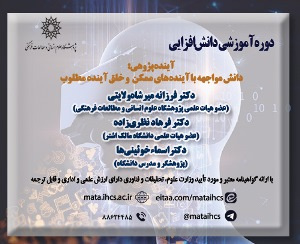تصحیح عباراتی از دینکرد نهم بر اساس زند یسن ها (مقاله علمی وزارت علوم)
درجه علمی: نشریه علمی (وزارت علوم)
آرشیو
چکیده
در این مقاله ابتدا به محتوای نسک های گاهانی موجود در دینکرد نهم و ارتباط آن ها با زند موجود یسن ها و نحوه مواجهه هر یک از این نسک ها با زند یسن ها اشاراتی شده است. نقل قول های گاهانی از زند یسن ها در خلاصه نسک ها، در مواردی ترجمه پهلوی یسن ها و گاهی تفسیر آن ها هستند، یعنی شرحی که بر ترجمه پهلوی نوشته شده است. این نقل قول ها گاهی عین عبارات زند هستند و گاهی با آن ها تفاوت دارند. آمدن این نقل قول ها ممکن است نشانه آن باشد که یسن های پهلوی پیش از تدوین نهایی نسک ها، که خلاصه آن ها در دینکرد آمده، موجود بوده اند. بخش اصلی این مقاله تصحیح و تجدید نظر در خوانش برخی از لغات و عبارات موجود در ورشتمانسر نسک از دینکرد نهم، ترجمه احمد تفضلی، با استفاده از زند موجود یسن ها است. تفضلی خود نیز در پیشگفتار به این مطلب اشاره می کند که در ورشتمانسر نسک عباراتی از گاهان به پهلوی ترجمه شده اند. با بررسی چند عبارت در این مقاله، مشخص می شود که زند یسن ها ابزاری مهم در مطالعه متون پهلوی و خصوصاً متون پهلوی برگرفته از زند یسن ها است و کمک گرفتن از آن فهم این متون و مطالبی را آسان می کند که سعی در انتقال آن داشته اند. در هر مورد ابتدا متن اوستایی و سپس متن نسک از دینکرد نهم که دربردارنده خوانش تفضلی است ارائه، بعد از آن متن زند، که تصحیح به واسطه آن است، نقل و در پایان متن و ترجمه اصلاح شده عرضه می شود.Reconsidering Some Passages from Dēnkard 9 Based on the Zand of Yasna
In this article, the contents of the Gāthic Nasks existing in Dēnkard 9 and their relevance to the existing Zand of Yasna and how to deal with each of these Nasks with the Zand of Yasna have been discussed. Gāthic quotations of the Zand of Yasna in summaries of Nasks are sometimes the Pahlavi translation of Yasna and sometimes their commentary, which is an interpretation written on the Pahlavi translation. quotations are sometimes the same as the Zand phrases, and sometimes are different from them. The occurrence of these quotations may indicate that the Pahlavi Yasna existed before the final compilation of the Nasks summarized in Dēnkard 9. The main part of this article is dealt with revising the reading of some words and phrases in Varštmānsar Nask, translated by Ahmad Tafzzoli, using the existing Zand of Yasna. Tafazzoli has mentioned that some phrases in Varštmānsar Nask have been translated to Pahlavi from the Gāthas. Examining some phrases from Varštmānsar in this article shows that the Zand of Yasna is an important tool in studying Pahlavi texts, especially the texts which are derived from the Zand of Yasna and is useful in understanding these texts and the contents they have tried to convey. In each case, first the Avestan text and then the text of Varštmānsar Nask in Tafazzoliʼs reading and translation has been given. Then the text of the Zand on which the revision is based has been mentioned. Finally, the authors tried to revise the text and translation.




